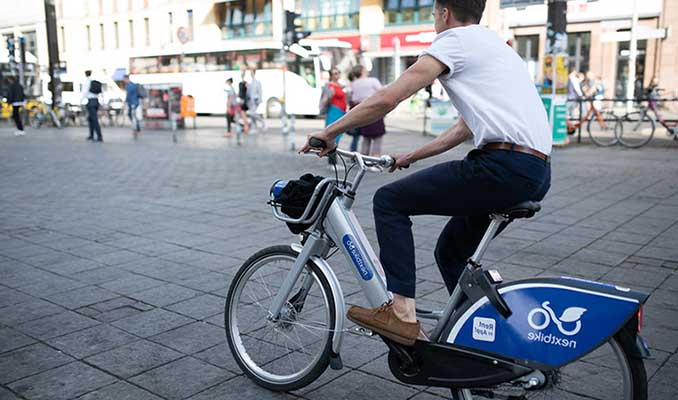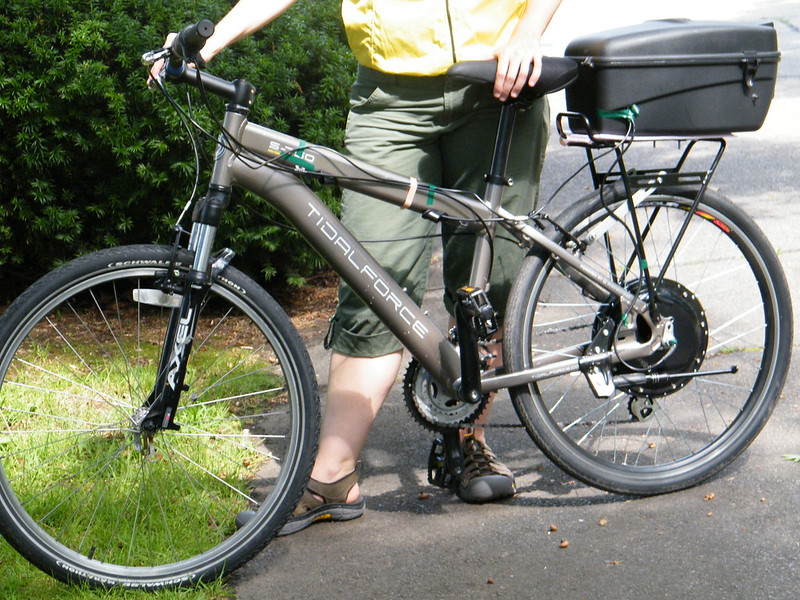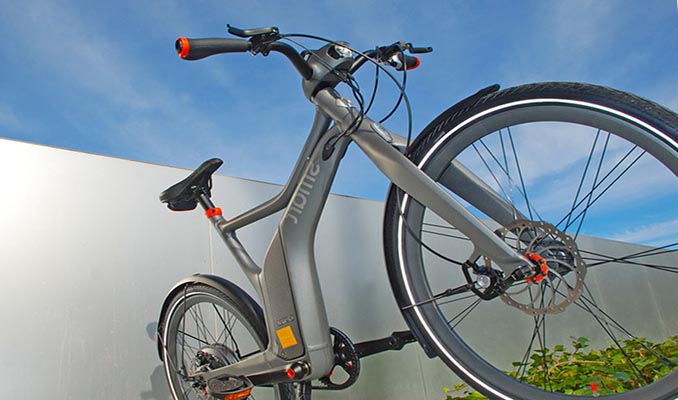To extend your e-bike’s range, follow these tips: optimize battery usage (20-80% charge), use assist modes wisely, pedal efficiently, maintain your body’s energy levels, and consider external factors like terrain and weather conditions.
On an e-bike or electric bicycle, battery life is a crucial aspect that defines the limits of the bike and the types of routes you can take.
Here are some tips to optimize your battery charge. Battery capacity is important, but there are many other factors at play, such as mechanics, rider management, and various external factors.
Read more: How Much Does An Electric Bike Weigh?
Factors That Affect the Range of an E-Bike
Here are some measures you can take advantage of to increase the range of your bicycle:
Battery Capacity
This value is expressed in Wh (watt-hours) and indicates the amount of electrical energy the battery can produce and sustain over a specific period of time. Currently, e-bikes with different battery capacities are available, depending on the model. Generally, they range from 250 Wh (touring or folding e-bikes) to 900 Wh (long-distance electric mountain bikes).
Battery Lifespan
Regardless of its capacity, a battery’s range diminishes due to usage and charging cycles. Depending on the model, batteries tolerate between 500 and 1,000 full charges. However, after three or four years of continuous use, an e-bike battery can experience a decrease of up to 30%.
Bike Weight
The weight of the bike is a decisive factor in range calculation. This value determines both the power delivered by the motor (expressed in Nm/newton-meters) and the battery capacity.
Both should be adapted to the weight of the bike-rider combination. In recent years, the emergence of lightweight e-bikes (under 20 kg) has led to increased range due to a better ratio between bike weight and battery capacity.
Lightweight e-bikes optimize their range through a better ratio between bike weight and battery capacity.
Motor Type
The motor of a certified e-bike must never exceed 250 W. That’s why they all have the same power. The difference lies in how this power is delivered to assist pedaling in the initial moments (known as torque).
This delivery is expressed in Nm (Newton meters). It is not limited by law and also affects the bike’s range. Additionally, different assistance modes (varying power outputs) and their frequency of use also determine the actual range.
Efficient use and adjustment of assistance modes are crucial to avoid wasting range.
Energy consumption is not the same when pedaling in economy mode (Eco), with limited power output (approximately 30-50%), compared to pedaling in maximum mode (Boost or Turbo, at 100%).
On the other hand, more advanced e-bikes allow adjusting the power delivery for each mode through specific software or apps. This high degree of customization enables adapting energy consumption to individual needs.
Tire Choice
Tires clearly influence the range of an e-bike. They are the point of contact and friction between the vehicle and the ground. The larger the contact surface, the greater the energy demand from the battery. The tread size directly affects battery consumption to compensate for tread friction.
Rider Weight
The weight of the rider’s body, along with the weight of gear and accessories, is a factor that clearly affects range. According to data provided by Bosch, one of the main e-bike motor manufacturers, every kilogram less in rider weight translates to approximately 1 km more range.
Riding Style
The use of the electric assistance system also affects the range. Some riders find sufficient assistance in the economy or medium modes. Others require an extra boost to overcome the same obstacles, which requires a higher assistance mode. As mentioned before, using Turbo mode consumes more energy and substantially reduces the nominal range.
Type of Route/Terrain
The slope and conditions of the terrain (asphalt, dirt, gravel, rocks) are factors that strongly influence the range. Transitioning from a flat or paved route to a hilly, off-road, or gravel route (of the same distance and under the same weather conditions) can result in a reduction in range of approximately 15-20 km.
Weather Conditions
The actual range of an e-bike varies from season to season due to temperature, humidity, etc. In winter, it tends to last a bit less than in summer. It is also influenced by the wind, which requires additional assistance to maintain a constant speed.
Tips to Preserve the Range of Your E-Bike
Taking into account the factors described above, although others could be added, you can use some tips to save energy and preserve (and even increase) the range of your e-bike. This savings will allow you to extend the useful life of the battery and enjoy much longer trips. Here are the most relevant tips:
Avoid Overcharging the Battery
For proper battery usage, it is always advisable not to let it discharge completely, and it is preferable to avoid charging it to the maximum as well. To have efficient charging, it is recommended to recharge the battery between 20% and 80%. Don’t worry, every battery always has a safety charge that prevents it from being completely depleted.
Wait a Bit Before Charging the Battery
Do not connect the charger immediately after finishing your ride. The cells being charged need time to transition from the discharge phase to the charging phase. Therefore, it is necessary to wait a few hours for them to cool down and adapt to the ambient resting temperature. However, don’t wait until the next day to recharge, especially if you have already consumed most of the energy.
Check the Components of Your E-Bike
Before every ride, like with any other bicycle, check key components such as suspension, tire pressure, chain lubrication, etc. These are components that affect battery wear. Adjust the fork and shock absorber to the pressure recommended by the manufacturer and the type of terrain you intend to ride on.
Keep the chain clean and well-lubricated and inflate the tires with a pressure gauge pump before every ride. These are small details that will save you dozens of kilometers.
Carry Essential Equipment
Do not add more accessories, clothes, or food than is strictly necessary. It is important to be well-equipped with spare parts and tools, especially if you are in the mountains. However, you need to find the right balance so as not to weigh down the bike.
In this regard, it is recommended to carry a compact multitool instead of multiple loose wrenches or chain cutters. You can also carry water in a backpack for hydration and forget about water bottles to achieve better weight distribution.
Utilize a Battery Extender
Many electric bikes are designed for new horizons and long trips. More and more models are compatible with portable supplementary batteries that add capacity and autonomy.
If you enjoy riding your e-bike for hours on end or embarking on multi-day journeys, we recommend purchasing a battery extender.
They are usually installed in the bottle cage area, attached to the seat tube, etc. It is more cost-effective than an original battery and can be easily carried in a backpack or bag.
Ride Efficiently
It is not advisable to push the assistance system to the maximum. Riding predominantly in Turbo mode, abusing the Walk mode to push the bike while walking, swerving excessively… All these actions quickly drain the battery.
Use the assistance modes intelligently: Eco and Trail (30-70% assistance) for flat, steep, or slightly technical climbs, and Boost for specific moments of maximum demand (hill tests, steep slopes, etc.).
Remember that your e-bike will not exempt you from pedaling and exerting energy. Remember that we are talking about pedal-assist bicycles, not mopeds.
Stay Fit and Train
Purchasing an electric bike can lead to the false belief that you can conquer any route without the need for training. This is false. Firstly, if you overuse the electric bike, you waste its range and reduce the battery’s lifespan.
That’s why we can save energy by putting in a bit more effort ourselves. We recommend being consistent in your outings with your e-bike, pedaling efficiently, taking care of your body by eating well and staying hydrated, and training your technique on challenging sections, climbs, etc. This will allow you to feel better on the bike, with direct benefits to your range.
Share this article with your cycling group!










